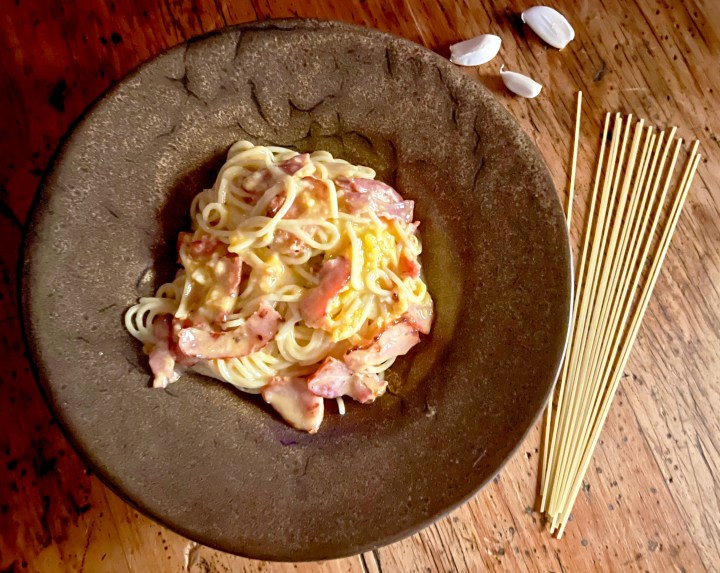QUEEN OF SAUCES
Throwback Thursday: Carbonara, pasta royalty

There’s something about carbonara. It’s unlike any other pasta sauce. Silken. Sensuous. Like the supermodel gliding down the catwalk in a gown so fabulous that every eye is mesmerised. It’s the pasta sauce that stands out from the crowd.
In the US, the pasta sauce we call carbonara was once termed “coal miner’s spaghetti”. But its origins in Italy are obscure. One theory is that it gained its name when it was on the menu at La Carbonara restaurant in Rome. Another has it that it was eaten by Italian charcoal workers who laboured with charcoal burners called carbonari.
This is not to be confused with the Carbonari secret society of charcoal burner workers whose rebellious activities lasted for the first three decades of the 19th century, although Wikipedia avers: “It has even been suggested that it was created as a tribute to the Carbonari (“charcoal men”) secret society prominent in the early, repressed stages of Italian unification in the early 19th century.”
One pervasive theory has it that it was created by American GIs who remained in Italy after World War 2 who, after the Allied liberation of Rome in 1944, decided to add pasta to their breakfast, or took their egg and bacon rations to restaurants to add to their pasta. I have my doubts about this, and Wikipedia does tend to favour American interpretations. But La Cucina Italiana notes: “Supporting this story is the first written reference to the dish in newspaper La Stampa in 1950, describing it as a dish prized by American servicemen. Shortly after, carbonara also appears in Elizabeth David’s classic 1954 book, Italian Food.” So the jury’s out.
Then again, a version of carbonara – the recipe, if not the name – then called pasta cacio e uova, a dish of pasta “tossed with melted lard, beaten raw eggs, and cheese”, was documented in Ippolito Cavalcanti’s 1839 Neapolitan cookbook, La Cucina Italiana adds. Note the absence of any pork as such, though it may have been pork lard.
Guanciale is the traditional smoked pork cheek that is added to carbonara once it has been tossed through beaten eggs and cheese, though today it is often pancetta (cured pork belly) that gets the nod. Elsewhere in the world, we often substitute cubes of bacon, nice and crisp, which do the job. All of these products are costly, so we should not be embarrassed about using bacon, which is hellishly expensive today, but still cheaper than guanciale or pancetta.
The traditional cheese for it is pecorino romano, and the required seasoning is black pepper. It is strictly not traditional to include either cream or butter, even though modern versions sometimes do use them. There are variations with garlic, but this significantly alters the overall flavour, which is meant to be simple: Eggs, smoked pork (in one or other version), cheese, black pepper. There is no need for salt, but you can salt the pasta water in which you cook your spaghetti.
And spaghetti is traditional too, though linguine, bucatini or fettuccine can be substituted.
(Serves 2 generously)
Ingredients
500 g spaghetti, cooked in lightly salted water until al dente and drained
3 eggs
3 egg yolks
200 g grated Pecorino Romano, grated
200 bacon, or guanciale, or pancetta, diced
Black pepper
Method
Put the pasta pot on with a little salt in it. When boiling briskly, add the spaghetti and cook until al dente. Try to time it for when your sauce is ready.
Fry the bacon and place the bits on a paper towel, on a plate.
Add the eggs and egg yolks to a heatproof bowl (big enough to hold the pasta too) and whisk them. Stir in the grated Pecorino Romano and a generous amount of black pepper.
Keep two ladlefuls of pasta water aside to add to the sauce later (optionally). Drain the pasta and immediately add to the bowl with the eggs and cheese. Toss it through with a pasta spoon or two forks, quickly so that the egg does not scramble. Optionally, stir in the reserved pasta water, or some of it. You may choose not to.
Add the cooked bacon (or guanciale or pancetta), toss again, and serve. DM
Tony Jackman is Galliova Food Writer 2023, jointly with TGIFood columnist Anna Trapido.
Follow Tony Jackman on Instagram @tony_jackman_cooks.
This dish is photographed in a bowl by Mervyn Gers Ceramics.




In England, even supposedly “real” Italian restaurants use cream for this dish, They say that’s how the English like it, which is probably true. However, having had my Italian friends cook it for me the Carluccio way there is simply no alternative. The video of Antonio cooking it in his wonderfully gentle way is all anybody needs as a reference. Just google carluccio carbonara & indulge yourself in the video found on Jamie Oliver’s YouTube channel
Yummy. I normally add white whine to the bacon and let it cook away for a while. And lots of fresh parsley to the egg and cheese mixture. Normally use only egg yolks, but will try this version.